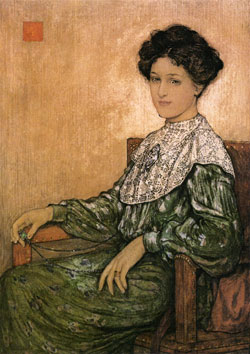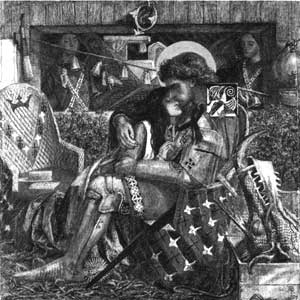John & Katharine Maltwood Collection
| View the Collection |
History of the Collection |
John & Katharine Maltwood |
Information Resources |
Background Maltwoods as Collectors Cultural Context
- Background - Mythology & the Pre-Raphaelites - In England - Arts and Crafts - New Sculpture The Arts and Crafts Movement in Victoria
The Collection Museum at "The Thatch" Notable B.C. Artists in the Maltwood Collection History of the Maltwood Collection (ppt 14.6 MB)
About Us Contact Us Visit Us Site Map

Cultural Context - Part 2: Mythology & the Pre-Raphaelites | ||||
Ruskin's serious, puritanical and moral approach to art appealed to artists associated with the Pre-Raphaelite group. He became a champion of Pre-Raphaelite ideas and from the foundation of the brotherhood in 1848, the Middle Ages began to be depicted by artists as a mystical, nascent socialist period. To it, they attributed all the virtues they felt the Victorian era had lost and hoped to regenerate society by ridding its surroundings of "vulgar" industrial manifestations. Such an approach can be seen especially in the work of Dante Gabriel Rossetti and Edward Burne-Jones whose paintings attempted to create a world of pure and poetic beauty inspired by a nostalgia for an imaginary twilight past. In addition to medieval themes they turned to ancient legends and sagas in the belief that these myths offered some fundamental truths relevant to nineteenth-century society. Katharine Maltwood was following this trend in her later investigations into Arthurian mythology. It was another facet of the historical approach to finding an ideal capable of improving the human lot.
In works such as Rossetti's The Wedding of St. George and the Princess Sabra, one of a series of watercolours from 1857, he presents a mystical, golden dream-world of chivalry and romance. While using medieval or legendary motifs and details, Rossetti's work also involved a more private symbolism and his main aim was to create atmosphere and emotional response. His work included illustrations to Thomas Mallory's Morte D'Arthur, a St. George series, subjects from Dante, and other biblical, moralizing and medieval, literary themes. Burne-Jones' paintings involved a mixture of Gothic spirituality and classical grace. After several trips to Italy the influence of Botticelli, Mantegna and Michelangelo became increasingly evident in his art. He executed works in a flat frieze-like technique with pale colours in an attempt to evoke an archaic, literary world of the past. These aspects of Burne-Jones style can be seen in works such as the Dream of Lancelot at the Chapel of the Holy Grail from 1896, which, solemn and still in atmosphere, represents the desire to escape present spiritual ills in a search for salvation and the ideal good. He was one of the most prolific painters of Arthurian legend and in addition drew subjects from classical mythology, the Bible, Chaucer, medieval romances and Italian literature. An important source of themes for both Rossetti and Burne-Jones was Morris's The Earthly Paradise, a compendium of classical and romantic tales presented in quasi-medieval style.4 They also both produced tapestry and stained glass designs for the Morris firm and were interested in the design and decoration of furniture. With the rise of the French literary Symbolist Movement in the later half of the nineteenth century the art of painters associated with the Pre-Raphaelites, particularly that of Rossetti, Burne-Jones, George Frederick Watts and the more aesthetic James McNeil Whistler, was linked with Symbolist circles on the Continent. The nostalgia in the work of these artists was an important aspect of Symbolist taste. In France they sought to escape from the banal in an art expressive of ideas and emotions and to avoid the materialism of their day in a life of the imagination. Art was no longer to be explicit but rather suggestive and expressive, an evocation of the mental and spiritual experience of the individual. The French Symbolist Movement generally dates from c. 1855 with Puvis de Chavannes and Gustav Moreau as its forerunners. Gaugin and the Nabis represent one aspect in their concept of synthesism which attempted to rediscover the hidden world of the emotions they felt industrial society had forced men to neglect. On the other hand there was the work of Odilon Redon and Eugene Carrière with its dream imagery and visions of supernatural fantasy. Katharine Maltwood, perhaps on one of her visits to Paris, purchased a signed print by Carrière, which reveals this personal and visionary side of Symbolism. There was never a clearly defined Symbolist school but only a number of centres, of which the most important were the Salon des Vingt in Brussels, the later Viennese Secession and the Rosicrucian group in Paris. As in England the French movement was a reaction to the growth of materialism and spiritual insecurity. In addition there was the pessimism of the fin-de-siècle mood, a self conscious preoccupation with decadence and evil, a fear of political degeneration and even the end of civilization itself. Joséphin Peladan's occult symbolism and establishment of the "Ordre de la Rose et Croix Catholique de Temple et du Graal", in the 1890's, may be seen in this context.5
All content on this page is copyright © 7 February, 2006 |
||||

